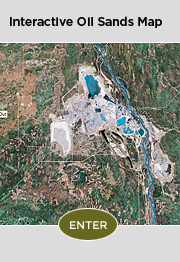Unearthing the Past
Fact: The Athabasca region was sculpted over millions of years – largely by water.
- In the early Cretaceous period (205 to 65 million years ago) period, the mountains were rising in the western part of the province and the sea was flooding the north.
- There were three large valleys draining the northern part of the province, and one was the McMurray Channel. Where the McMurray Channel met the sea, an enormous amount of sand – about 2.5 trillion cubic metres – was deposited. This sand was shaped and spread over time by the forces of rivers and tides, covering organic material that would transform into oil.
- As the organic material turned into oil and seeped upward into the sand, rainwater and bacteria seeped down through sand, turning the oil into bitumen.
- While the oil within the sand turned to bitumen, sediment slowly accumulated over top of the layer for millennia. Today, bitumen remains entrained in sand at varying depths under the layer of accumulated sediment. Where the bitumen is located close to the surface under a thinner layer of sediment, it becomes economical to remove this overburden and dig the bitumen out using mining techniques. Where it is located deeper under the sedimentary layer, in situ drilling techniques are used.
Fact: It was a catastrophic event that created much of today’s landscape, and the powerful, natural forces at work in the area influenced the global environment.
- About 9,900 years ago, Lake Agassiz, an enormous glacial lake spread across Manitoba, Ontario, Saskatchewan, North Dakota and Minnesota, suddenly reversed its drainage from the Great Lakes to the Arctic Ocean.
- Much of the surging drainage water from Lake Agassiz entered the Arctic Ocean via the Clearwater River.
- During this flood, an incredible amount of earth was displaced as the 100-metre deep Clearwater Valley was created.
- When the drainage pattern of Agassiz changed, 21,000 cubic kilometres of water rushed into the Arctic Ocean raising the sea level world wide.
- Temperatures dropped dramatically throughout the northern hemisphere for about 100 years after the flood.
- As the floodwaters retreated over the next 400 years, an intricate landscape of ridges, knolls, escarpments, beaches, spits, peninsulas, and islands emerged.
Fact: The remains of several dinosaur-era aquatic animals have been found and preserved during mining excavations by oil sands developers.
- In the sediment above the McMurray oil sands formation, there have been several discoveries of prehistoric marine reptiles – specifically ichthyosaurs and plesiosaurs. Ichthyosaurs resemble large dolphins and plesiosaurs look much like the long-necked sea monsters from children’s books.
- Unearthed as a result of oil sands development, fossil samples that have been found would have otherwise remained underground and undiscovered.
- One of the most complete plesiosaur fossils ever found in North America was discovered during routine operations of a 100-ton shovel at a Syncrude site.
- Oil sands companies such as Syncrude have strict protocols to protect fossil finds from damage during the course of their operations.
- When a fossil is found, operations in the area are suspended and move to another area of the mine until the discovery can be evaluated and extracted, if appropriate.
- Oil sands companies educate heavy equipment operators and other employees on how to identify potentially significant finds.
Fact: Archaeological sites in the Athabasca lowlands date back 10,000 years and some of the oldest human artifacts in the province have been found there.
- One of the first archaeological sites unearthed by oil sands activity called the Beaver River Quarry revealed a spear point dating back 10,000 years.
- The Quarry of the Ancestors, located on Birch Mountain Resources’ lease, helped archaeologists uncover the source of fine-grained sandstone used by the ancient people of northern Alberta and Saskatchewan to make weapons and tools. It is the oldest prehistoric quarry in Alberta.
- Over 300,000 archaeological artifacts have been found in the oil sands mining area.
- Dating of tools has confirmed that ancient peoples lived in the area even before the Lake Agassiz flood and may have inhabited the area up to 12,000 years ago.
- Analysis of spear points recovered in the Quarry of the Ancestors revealed mammoth blood as well as the blood of many other animals including caribou, bear and bison.
- Scientists believe the quarry may have been one of the first places of prehistoric human settlement in northern Alberta after the glaciers receded back into the Northwest Territories and the area become accessible.
Fact: Industry, government and Aboriginal communities work together to protect historic sites, and development has led to some of the most important archaeological discoveries in the province.
- The provincial government has a regulated system for ensuring historical resources such as archaeological sites are protected.
- Heritage Resource Impact Assessments (HRIA) are conducted at developers’ expense before a permit for development can be obtained.
- These assessments are subcontracted by developers to qualified archaeologists.
- These surveys have identified the highest density of pre-contact archaeological sites in Alberta, and one of the highest in North America.
- Oil sands activity has led to hundreds of significant archaeological finds as comparatively little funding went into exploring the archaeology of Canada’s boreal forests before developers began undertaking HRIAs.
- Artifacts found during an HRIA for Shell Canada led to the discovery of 49 new sites on the eastern side of the Athabasca River and also led archaeologists to the discovery of Creeburn Lake, which is estimated to have been inhabited between 9,400 and 7,750 years ago.
- The Creeburn Lake site has been protected as a Provincial Historical Resource by the government of Alberta and the Quarry of the Ancestors is currently being evaluated for qualification under the same status.
Facts sourced by Oil Sands Developers Group (October 2009).
Sources for all facts available upon request.




















